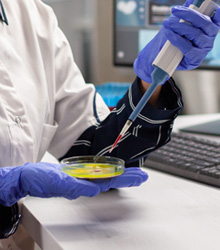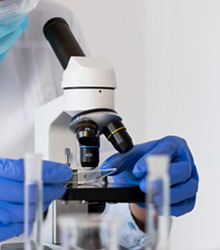DNA and Stem Cells Cancer Research
- Home
- DNA and Stem Cells Cancer Research


DNA & Stem Cells
Cancer Research
Using genetics and stem cell treatments in the context of cancer
Involves a combination of approaches aimed at understanding the genetic basis of cancer and harnessing the regenerative potential of stem cells. Using DNA to analyze, treat, and potentially cure cancer involves several approaches that leverage the information encoded in the genetic material. Here's an overview of how DNA is utilized in the context of cancer:Genetic Analysis and Profiling:
DNA analysis is used to identify genetic alterations in cancer cells. This includes techniques such as next-generation sequencing, array-based methods, and polymerase chain reaction (PCR) to detect mutations, gene amplifications, deletions, rearrangements, and epigenetic changes. Genetic profiling helps characterize the specific genetic makeup of an individual's cancer, providing insights into its behavior, prognosis, and potential treatment options.Targeted Therapies:
DNA analysis helps identify specific genetic alterations or mutations that drive cancer growth. This information guides the development and use of targeted therapies that selectively inhibit or modulate the activity of these specific genetic targets. Targeted therapies can include small molecule inhibitors, monoclonal antibodies, or other drugs designed to interfere with the function of mutated or overactive genes or their corresponding proteins.Precision Medicine
Precision medicine aims to tailor cancer treatment to an individual's specific genetic profile. By analyzing the genetic makeup of a patient's tumor, treatment strategies can be customized to target the specific genetic alterations driving that particular cancer. This approach enhances treatment efficacy while minimizing unnecessary treatments and potential side effects.Immunotherapy and Cancer Vaccines
DNA-based immunotherapies utilize the patient's own immune system to target and eliminate cancer cells. This can involve genetic engineering techniques, such as inserting genes encoding immune-stimulating molecules, into immune cells (e.g., T cells) to enhance their ability to recognize and kill cancer cells. Cancer vaccines can also be developed using DNA-based approaches to stimulate the immune system's response against specific tumor-associated antigens.Liquid Biopsies and Circulating Tumor DNA (ctDNA):
DNA analysis techniques can be applied to liquid biopsies, which involve analyzing cell-free DNA circulating in the bloodstream. By detecting ctDNA, genetic changes specific to the tumor can be identified non-invasively. This approach can provide valuable information about tumor progression, treatment response, and the emergence of resistance mutations.Gene Therapy
Gene therapy involves introducing therapeutic DNA into cancer cells to modify their genetic material. This can include techniques such as introducing tumor suppressor genes to inhibit cancer cell growth, inserting suicide genes to induce cell death, or utilizing viral vectors to deliver therapeutic genes directly to tumor cells. Gene therapy aims to correct genetic abnormalities or enhance the immune system's ability to target cancer cells.Stem Cells In Cancer Research
a. Hematopoietic Stem Cell Transplantation (HSCT):
High-dose chemotherapy or radiation therapy can damage the bone marrow, which is responsible for producing blood cells. Hematopoietic stem cells (HSCs) can be collected from the patient or a compatible donor and transplanted back into the patient's body to restore healthy blood cell production.b. Mesenchymal Stem Cells (MSCs):
MSCs have been studied for their potential in delivering therapeutic agents directly to tumor sites or modulating the immune response against cancer cells. They can be engineered to produce anticancer agents or act as carriers for targeted drug delivery.c. Stem Cell-Based Immunotherapies:
Certain types of stem cells, such as natural killer (NK) cells and T cells, can be genetically modified to enhance their anticancer properties. Genetic modifications can include introducing chimeric antigen receptors (CARs) or T cell receptors (TCRs) that specifically recognize and target cancer cells, boosting the immune response against tumors.d. Tissue Engineering and Regenerative Approaches:
Stem cells, along with biomaterials and scaffolds, can be used to engineer tissue constructs for reconstructive surgeries following cancer resections. This can aid in restoring form and function to the affected area.Gene
Therapy
A scientific procedure that involves modifying a patient's genes to treat or cure a disease, with the goal to correct or replace a defective or missing gene or, to introduce a new gene that can help the body fight disease..
DNA
Transcription
The process by which genetic material or information in Deoxyribonucleic Acid {DNA} is used to synthesize a complementary Ribonucleic Acid {RNA} molecule.
Translational Research
Involves Several Stages
Basic Scientific Research
This involves conducting laboratory-based studies to better understand the underlying mechanisms of disease and identify potential targets for therapy.


Preclinical & Clinical Research Trials
Preclinical involves testing potential therapies in-vitro for efficacy. Clinical involves testing potential therapies in human subjects to determine safety and efficacy.
Implementation
This involves implementing successful therapies into clinical practice and monitoring their effectiveness in the real world.






